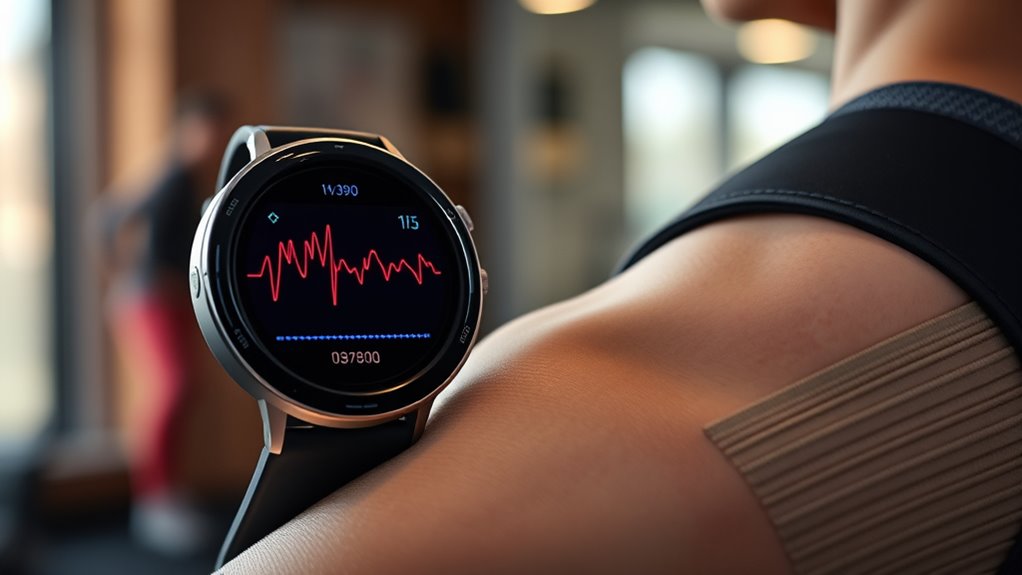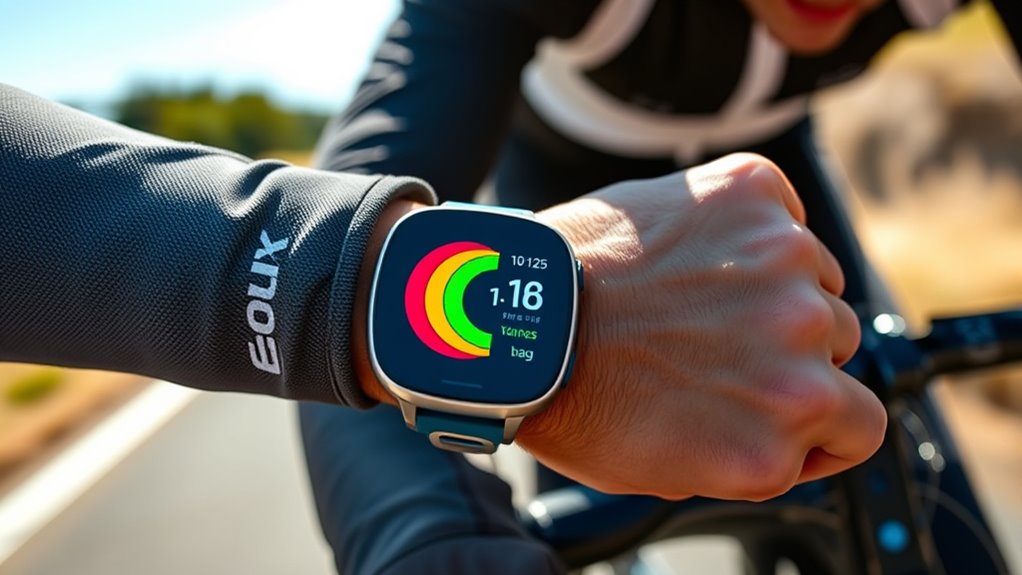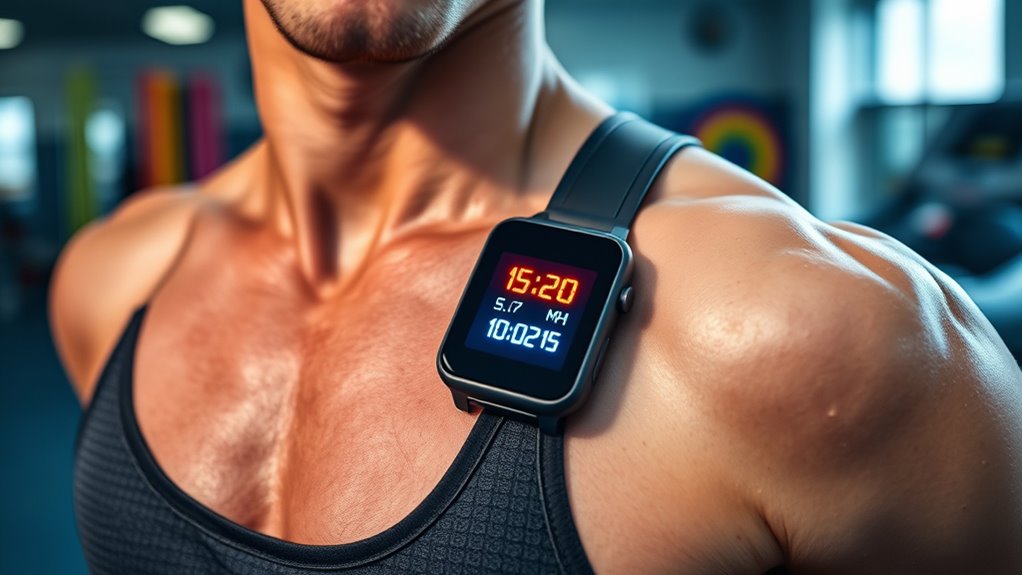Heart-rate-based training helps you optimize workouts by using your heart rate to guide intensity. You can measure it manually or with a monitor to stay within specific zones that match your fitness goals. Knowing your maximum heart rate and target zones helps prevent overtraining and ensures effective progress. Focusing on your heart rate also enhances recovery and safety. Keep exploring to learn how to accurately incorporate these principles into your routine for better results.
Key Takeaways
- Heart rate variability indicates recovery status and fitness level, guiding personalized training adjustments.
- Monitoring heart rate helps ensure workouts stay within targeted zones for optimal effectiveness.
- Heart rate zones are based on percentages of maximum heart rate, aligning effort with fitness goals.
- Accurate measurement, via monitors or manual checks, is essential for precise training and safety.
- Using heart rate data prevents overtraining, improves performance, and supports cardiovascular health.
Understanding Heart Rate and Its Measurement

Understanding your heart rate and how to measure it is essential for effective training. Your heart rate variability reflects the subtle changes in the time between beats, offering insights into your recovery and overall fitness. Monitoring this can help you gauge how well your body adapts to exercise stress. Additionally, recovery heart rate, measured immediately after exercise, indicates how quickly your heart returns to resting levels. A faster recovery signifies better cardiovascular health and fitness. Using a heart rate monitor makes tracking these metrics straightforward, giving you real-time feedback. By paying attention to these measurements, you can tailor your workouts more precisely, ensuring you’re training at the right intensity and supporting ideal progress. This understanding forms the foundation for smarter, safer training.
The Importance of Heart Rate Zones

Understanding your heart rate zones helps you target the right workout intensity for your goals. By defining these zones, you can guarantee you’re training effectively and safely. This knowledge allows you to optimize each session and see better results over time. Incorporating auditory cues during your training can further enhance your focus and performance. Additionally, understanding how different glycolic acid concentrations impact skin can help tailor skincare routines to your needs. Recognizing the benefits of glycolic acid exfoliation can guide you in choosing appropriate skincare products for specific skin concerns. As the adoption of AI in various sectors continues to grow, leveraging AI-driven safety measures can further enhance training safety and effectiveness.
Defining Heart Rate Zones
Knowing your heart rate zones is essential because they help tailor your training to maximize efficiency and safety. These zones are typically defined by training zone percentages, which correspond to different levels of effort. Your heart rate variability can influence how you respond to each zone, so understanding these ranges helps you stay within safe limits while pushing your boundaries. Monitoring heart rate is crucial for adapting your training intensity to your current physical state. For example, low-intensity zones (50-60%) promote recovery, while higher zones (80-90%) boost endurance and performance. Accurate heart rate measurement allows for more precise tracking and adjustments during exercise. By accurately defining your zones, you can monitor your progress more effectively and avoid overtraining or injury. Establishing clear boundaries based on your heart rate variability ensures your training is both targeted and adaptable, helping you reach your goals faster and more safely. Recognizing the comparative advantage of tailored training methods can further optimize your performance outcomes. Additionally, understanding training zone percentages allows for more precise adjustments in your workout intensity to match your fitness level.
Optimizing Workout Intensity
Optimizing workout intensity hinges on effectively using your heart rate zones to match your training goals. By staying within the right zones, you guarantee you’re challenging yourself without overtraining, which supports better performance and recovery. Incorporate nutrition strategies, like proper hydration and fueling, to sustain your effort and prevent fatigue. Recovery techniques, such as stretching and active rest, help your body adapt and improve. Monitoring your heart rate allows you to fine-tune intensity during each session, ensuring you stay in the ideal zone for endurance, fat burning, or speed development. Consistently adjusting your effort based on heart rate feedback helps maximize your training efficiency while reducing injury risk. Understanding Gold IRA Rollovers can provide additional diversification options for long-term financial health. Making use of heart rate monitor technology can further enhance your ability to stay within your desired zones. Incorporating data-driven strategies into your training plan ensures you’re making informed decisions to optimize results. Mastering these elements ensures you get the most out of every workout, balancing intensity with effective recovery. Additionally, understanding well-being tips can enhance your overall training experience and support long-term health.
Calculating Your Maximum Heart Rate

To accurately determine your maximum heart rate, you need to understand the common methods used for calculation. The most straightforward approach is the age-based formula: subtract your age from 220. This simple calculation offers a quick estimate, but keep in mind it provides a general guideline rather than a precise number. Age considerations are important because maximum heart rate naturally declines as you get older. Some people may have a higher or lower maximum, depending on genetics, fitness level, and health. For more accurate results, you could perform a maximal exercise test under supervision. Additionally, factors like biological variability can influence your true maximum heart rate beyond the general estimate. Recognizing individual differences can help you tailor your training zones more effectively for safety and performance. Understanding your cardiovascular health can also influence how you interpret your maximum heart rate and adjust your training accordingly. Incorporating regular monitoring can help you track your heart rate responses over time and refine your training zones.
Identifying Your Target Heart Rate Zones

Once you have an estimate of your maximum heart rate, the next step is to identify your target heart rate zones. These zones help you tailor your workouts for ideal results and recovery. Your heart rate variability can indicate how well your body handles different intensities, guiding you in selecting appropriate zones. During exercise, staying within specific zones ensures you’re training effectively without overtaxing yourself. For instance, moderate zones improve endurance, while higher zones boost performance. Recognizing your zones also aids in exercise recovery, preventing burnout and injury. Use a heart rate monitor to track your intensity, adjusting as needed based on how your body responds. Properly identifying your zones makes heart-rate-based training more effective and personalized, helping you achieve your fitness goals safely. Incorporating expert voice actors in your understanding of training concepts can make learning more engaging and memorable. Additionally, understanding market trends and insights can help you optimize your training approach by aligning it with current fitness industry developments. Being aware of security zone info can also be beneficial for safeguarding your personal data and privacy during digital training sessions, ensuring a secure learning environment. Recognizing essential oils for recovery can further enhance your training by promoting faster muscle relaxation and reducing soreness.
Benefits of Heart-Rate-Based Training

Tracking your heart rate during exercise offers clear advantages for improving your fitness. It helps you move beyond training myths that suggest only high-intensity cardio delivers results, showing that heart-rate-based training balances cardio versus strength effectively. By staying within your target zones, you optimize fat burn, boost endurance, and prevent overtraining. Heart-rate monitoring guarantees you’re working at the right intensity, avoiding the misconception that more effort always equals better results. It also personalizes your workouts, allowing adjustments based on your progress. This approach promotes consistency and sustainable improvements, helping you reach your fitness goals faster. Additionally, understanding Best Airless Paint Sprayer can help you choose the right equipment for your projects, ensuring efficient and high-quality results. Considering the different performance metrics of sprayers ensures you select a device that meets your specific needs and enhances your project outcomes. Ultimately, heart-rate-based training makes your workouts smarter, not harder, ensuring each session contributes effectively to your overall health and performance. Incorporating mental wellbeing awareness into your routine can further enhance your motivation and resilience during training.
Practical Ways to Monitor Your Heart Rate During Exercise

There are several practical ways to keep track of your heart rate during exercise. You can use heart rate monitors, manual pulse checks, or mobile apps and devices to get real-time data. Choosing the right method depends on your workout style and preferences, making it easier to stay within your target zone.
Using Heart Rate Monitors
Using a heart rate monitor is one of the most effective ways to keep track of your exertion level during exercise. It provides real-time data on your heart rate variability and helps you stay within your target zones. To get the most out of it:
- Check your resting heart rate regularly—lower rates indicate better cardiovascular health.
- Use the monitor to track heart rate variability, which shows your recovery status and stress levels.
- Adjust your intensity based on the data, ensuring you’re training in the appropriate zone for your goals.
Wearing a monitor keeps you aware of subtle changes in your exertion, helping you train smarter. This approach makes it easier to optimize your workouts, prevent overtraining, and improve overall heart health efficiently.
Manual Pulse Checks
Manual pulse checks offer a practical and immediate way to monitor your heart rate during exercise without any equipment. To do a manual pulse, locate your pulse point—commonly your wrist or neck—and use your index and middle fingers to press lightly. Count the beats for 15 or 30 seconds, then multiply to find your beats per minute. This simple physical assessment helps you stay within your target heart rate zone and adjust your effort accordingly. Manual pulse checks are especially useful when you want a quick, reliable way to gauge your intensity without relying on gadgets. Regularly practicing this method sharpens your awareness of your body’s signals, making it an essential skill in any heart-rate-based training routine.
Mobile Apps and Devices
Mobile apps and devices offer a convenient and accurate way to monitor your heart rate during exercise, allowing you to stay within your target zones with minimal effort. Wearable technology, such as fitness trackers and smartwatches, makes it easy to track your heart rate in real-time. These devices often sync data automatically, providing seamless data synchronization across apps and platforms so you can analyze your progress. To get the most out of these tools, consider these options:
- Use a fitness tracker or smartwatch that continuously monitors your heart rate.
- Sync your device with compatible apps to analyze trends and optimize training.
- Leverage wearable technology’s real-time feedback to adjust your intensity instantly.
This tech integration simplifies tracking, enhances accuracy, and helps you stay focused on your fitness goals.
Tips for Incorporating Heart-Rate Zones Into Your Workouts

To effectively incorporate heart-rate zones into your workouts, start by understanding your target zones and tracking your heart rate accurately throughout exercise. This allows you to tailor sessions like interval training or cross training for ideal results. Use a heart-rate monitor to stay within your desired zone, adjusting intensity as needed. For example, during high-intensity intervals, push into your anaerobic zone, then recover in your aerobic zone. Cross training benefits from mixing activities in different zones, preventing plateaus. Here’s a quick guide:
| Heart-Rate Zone | Intensity Level | Best For |
|---|---|---|
| Zone 1 | Very light (50-60%) | Recovery, warm-up |
| Zone 2 | Light (60-70%) | Base endurance |
| Zone 3 | Moderate (70-80%) | Aerobic capacity |
| Zone 4-5 | Hard to maximum effort (80-100%) | Interval training, speed |
Adjust your workouts based on these zones for balanced training.
Frequently Asked Questions
How Often Should I Reassess My Target Heart Rate Zones?
You should reassess your target heart rate zones every few months, especially if your resting heart rate or exercise intensity changes. Regular check-ins help guarantee you’re training effectively and safely. Track your resting heart rate regularly, as it reflects your fitness level. Adjust your zones if you notice improvements or if your exercise intensity feels too easy or hard. Staying updated keeps your training ideal and personalized.
Can Heart Rate Training Improve Athletic Performance Significantly?
Heart rate training can greatly boost your athletic performance by enhancing cardio benefits and helping you train more efficiently. It enables you to target specific intensity zones, improving endurance and strength. Additionally, using heart rate zones helps prevent overtraining and injury, allowing you to recover properly. By consistently monitoring your heart rate, you guarantee ideal training, leading to better results and reduced risk of setbacks.
What Are Common Mistakes to Avoid in Heart-Rate-Based Training?
Avoid alliteration and abrupt mistakes by steering clear of common errors in heart-rate-based training. You should watch out for overtraining pitfalls, which can cause fatigue and injury, and equipment inaccuracies that give false readings. Don’t push too hard or rely solely on gadgets; instead, balance effort with rest and double-check your devices for precision. Staying mindful helps maximize your workout’s effectiveness and keeps you healthy.
How Do Factors Like Stress or Dehydration Affect Heart Rate?
Stress impacts your heart rate by increasing adrenaline, which can make your heart beat faster even if you’re not exerting yourself. Dehydration affects hydration levels, leading to a higher heart rate because your body struggles to cool itself and maintain blood flow. Both stress and dehydration skew your heart rate readings, so you might think you’re working harder than you actually are. Stay hydrated and manage stress to keep your heart rate accurate during workouts.
Is Heart-Rate Training Suitable for Beginners or Only Advanced Athletes?
Heart-rate training is beginner friendly and suitable for novices wanting to improve fitness safely. You don’t need advanced skills, as it helps you monitor effort and avoid overtraining. It’s a novice appropriate method that provides clear guidance on intensity levels, making it easier to stay motivated and track progress. Whether you’re just starting or looking to optimize your workouts, heart-rate training offers a structured, accessible approach for all fitness levels.
Conclusion
By understanding your heart rate and using it to guide your workouts, you set yourself up for better results and safety. Monitoring your zones helps you stay in the right intensity for your goals. Remember, “slow and steady wins the race,” so be patient and consistent. Incorporate heart-rate training into your routine, and you’ll see progress over time while enjoying a healthier, more effective workout journey.










